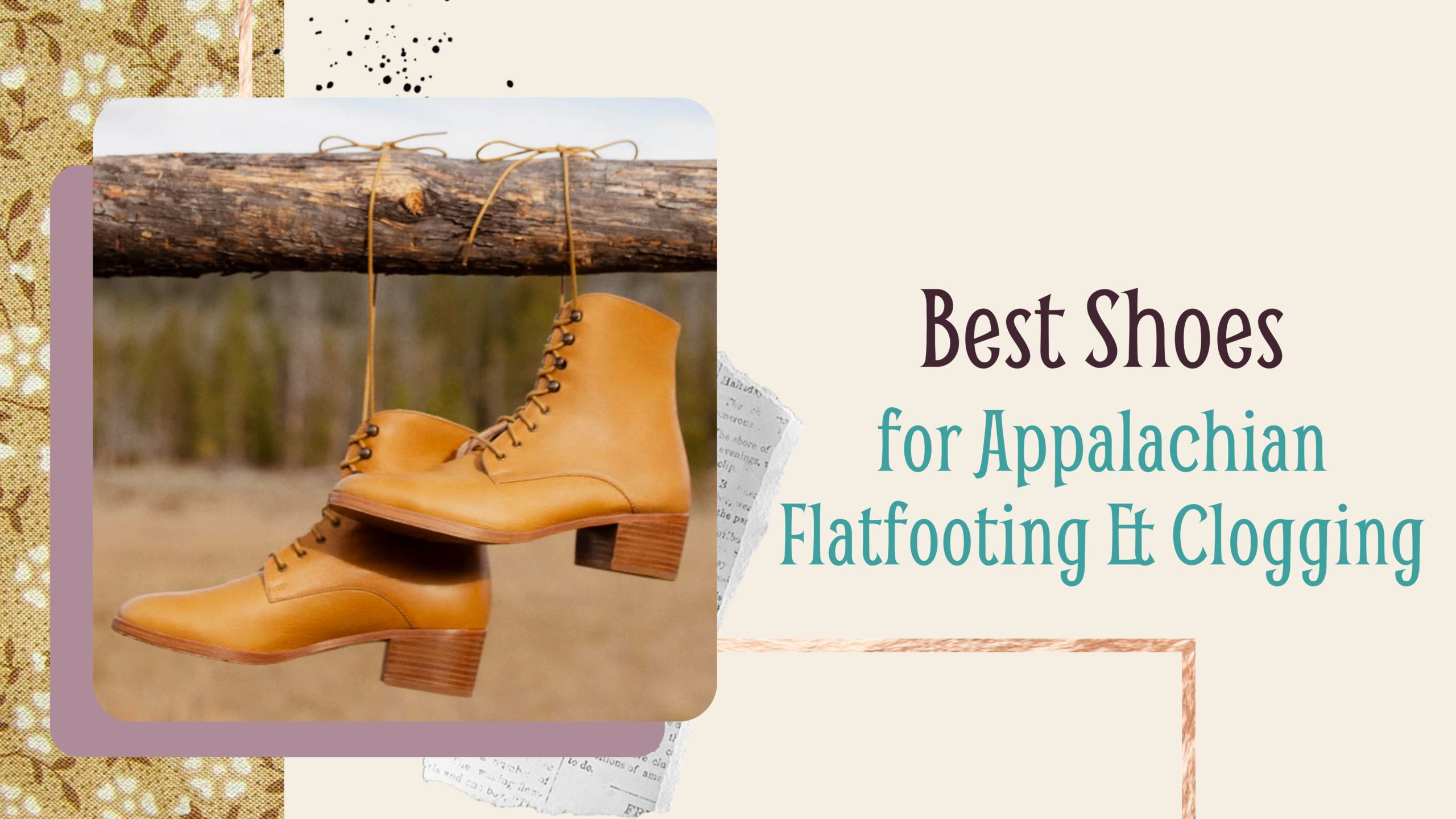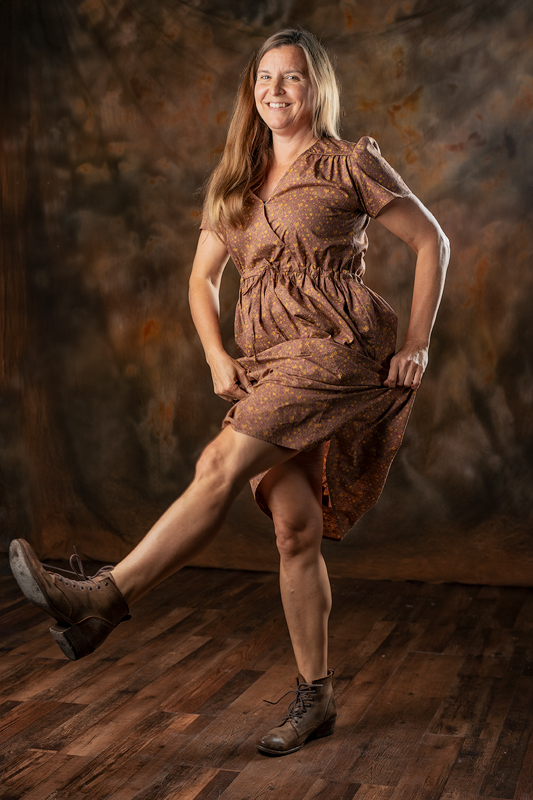Best Shoes for Appalachian Flatfooting & Clogging

Choosing the best shoe for Appalachian Flatfooting & Clogging is not a one-size-fits-all proposition. Here is some information to help you select the best shoe for YOU!
How do I pick a shoe?
This is always one of the first questions on folks’ minds when they start learning or diving deeper into Appalachian Dancing. I’d like to start with a cultural note and say that throughout the history of the dance form, people danced in whatever shoes they had, often just a single pair at any given time. The kind of shoes that many folks had were a sort of stout boot, which my Granny called “brogan boots”, and because rubber and plastic weren’t yet in wide use, they often had smooth leather soles.
(I later learned from a Gaelic-speaking friend that ‘brogan’ is the plural form of ‘brogue’, which means shoe in Gaelic, so there’s a trace of Scottish/Irish culture lingering in Appalachian language as well as dance.)
While there are many styles of shoes you can choose for flatfooting & clogging, leather-soled shoes are still my favorite for a variety of reasons, although they can be increasingly hard to find. I’ll go through the three main types here, as each can have advantages depending on your goals. At the end, I’ll list some links for purchase options.
Leather-soled shoes or boots
I find these to be the most versatile. They’re loud enough to be heard at jam sessions but not so loud that you’ll overpower the music. You can even wear them onstage if you use a low mic, and the sound is more earthy than a shoe with taps. They can also be a little easier to dance in than shoes with taps, so can be great for a beginner.
Depending on the moisture in the air, the dance floor, and the leather itself, they sometimes can have some friction which makes it harder to do chugs and steps that slide. You can remedy this by sprinkling some cornmeal or cornstarch on the dance surface.

I have a pair of Frye boots for when I want that “old-timey” look, and they have a nice sound, too. They are not cheap, so I recommend searching for sales. Two drawbacks that Frye boots have is that they can run a bit narrow, and also the toes often turn up at the end, which can make certain steps hard. However, they’re really gorgeous and they last forever, so I have a pair for those times when I know I’m going to be sticking to the basic steps and I want to have an old-time vibe to my outfit.
*Note: There are some shoes being made that have a leather-like sole that’s made out of a smooth plastic. This can be a cheaper alternative to leather as long as you make sure that they’re going to allow for chugging and sliding, so as to protect your knees.
Tap Shoes
Tap shoes can be a really versatile form of shoe, and often you can use them with or without taps. The drawback with taps is that sometimes you just want to be dancing and jamming on the side, and with taps on at a jam session or festival, you’re basically saying, “Look at me! I’m here and I’m loud!” This is not always popular with fiddlers or other festival-goers, even if you’re a great dancer!
On the other hand, if you’re dancing onstage, taps can be great because you often don’t even have to mic them.
Taps are also versatile and in a pinch, you can do other step dance styles in them, as well as (of course) TAP DANCE!
My personal favorite shoe to dance in is a pair of Capezio K360 professional tap shoes without the taps. (They come that way, without taps.)
For stage, I also have a pair WITH taps. They’re a classic oxford style, and I always get them in black, although they are available as saddle oxfords, too. They’re quite durable. I have a pair that is still going strong after 25 years.
These are also on the pricey side, but there are a number of other less-expensive tap shoes that are perfectly serviceable.
Jingle Taps/Clogging Shoes
This is what contemporary cloggers wear. They’re often white, but come in other colors. They have an extra wiggly part on the toe tap that regular tap shoes don’t have, and they produce a unique sound because of it. If you’re wanting to dance on a contemporary clogging team, you’ll need this kind of shoe. Otherwise, it’s not as versatile as other shoes you could choose, so I mainly include it here for reference and do not recommend it as a general flatfooting/clogging shoe.
Shoe Links
Before you get out your wallet to buy new shoes, you might want to check local thrift stores. Even if you’re not on a budget, sometimes it can be easier to find smooth-soled shoes at charity shops, and many of my students report success with that method. I even have a few friends who flatfoot in old bowling shoes, so you can choose whatever works for sound, comfort, and your personal style.
That being said, here are some favorite shops that my students and I patronize.
Note: I don’t receive any commission from any of these links, with the exception of Christy Dawn. I’m simply providing them for your reference.
Dance-Specific Shoes
Discount Dance Supply has lots of dance shoes, including clogging, tap, and character shoes. ( I have a pair of Capezio men’s oxford character shoes, a reasonably-priced option.)
Capezio has a website where you can get the K360s I love so much and many other styles.
You can get interesting period shoes with leather soles at Fugawee. They’re used by many historical re-enactors. You’ll have to experiment—look for smooth soles and low heels.
Street Shoes You Can Dance In
6 PM is an online store with a variety of shoes on sale, and sometimes you can find Fryes here at 50% off!
I’ve been hearing good things about the leather-soled Wolverine 1000-mile boots. They aren’t cheap, but they are comparable in price to Fryes.
Some dancers swear by bespoke London shoemakers Sanders and Sanders. This is a street shoe you’d adapt for dance, and I’ve heard they last for years and years.
Christy Dawn has some absolutely gorgeous and old-time looking boots for women with leather soles. They also make a nice leather-soled oxford, if you prefer a shorter shoe. These are NOT at all cheap, but fit the bill for flatfooting! At the time of writing this, the Dawn Boot and the Agnes Oxford are the two styles to look for. They also have some adorable old-timey dresses, evocative of a bygone era, ethically-made and perfect for dancing in style.
This link will take you to their website AND give you a discount code for your first order: http://rwrd.io/uh21xk0?s–
Beckett Simonon makes a variety of leather-soled shoes and boots for men. I don’t personally own any, but I’d consider ordering a men’s size to try these out. They’re gorgeous, and the oxfords and Balmoral boots seem to be the best they have for dancing. Pricey (they’ll set you back a minimum of $200 USD) but they are high-quality.
https://www.beckettsimonon.com
A Few More Honorable Mentions
Cowboy Boots-Some of my flatfooting and buckdance friends swear by cowboy boots to dance in. The heels are a bit higher than many dance shoes, and can take a while to break in, but if you’re a cowboy boot kind of person this might be the best option for you. I won’t suggest links as there are many options for boot purchasing. Again, if you go this route just look for the smoothest soles.
Resoled shoes-I’d be remiss in mentioning that if you find (or already have) some boots or shoes you LOVE, but they aren’t the right kind of soles, you can often find a shoe store to resole your shoes for somewhere in the neighborhood of $65-100 USD. Again, not the cheapest option, but if you get a pair of dance shoes you like, it’s priceless. I think of investing in well-made shoes the same way I do about buying an instrument, and they can be nearly as long-lasting!
Get Started Dancing Today!
Now that you’ve got your shoe situation sorted, why not get started dancing today? Here are some of the easiest ways to work with me:
1. Check out my free beginner video 3 Essential Steps for Appalachian Flatfooting & Clogging. It has everything you need to learn the 3 foundational steps that will give you a solid foundation in the style and get you ready for the dance floor!
2. CLICK HERE to join my free private Facebook Community to meet some sole-mates and share and learn more about Appalachian Flatfooting & Clogging!
3. If you’d like to go a little deeper, you can dive in to my Complete Beginner Toolkit for Appalachian Flatfooting & Clogging, which gives you instant access to the music, steps, sequences, culture, history, and EVERYTHING you need to start dancing and improvising!
What are you waiting for? Get out there and kick up your heels!
Note: I haven’t included any specific links for jingle taps (contemporary clogging shoes) here because that’s not what I teach. If that’s the style you’re most interested in, I recommend you check with a teacher who is geared toward that style, who’ll be able to provide much better advice about that type of shoe than I would.
• Enjoy original songs, banjo tunes, and mountain ballad downloads from the hills of East Kentucky
• Learn the basics of mountain percussive dance in my free instructional video “3 Essential Steps for Appalachian Flatfooting & Clogging”
• Snag our video guide to making your own herbal tinctures along with homey recipes from our family!
• Stay in touch about all things Appalachia with my fun weekly email, like a front-porch visit in your inbox!
Get a hearty helping of Appalachian Goodness with your free Mountain Mama Digital Care Package!
Free Gift
Website by Tracy Raftl Design
© 2023 Carla Gover
Menu
Follow me
Carla is currently based in Lexington, KY, ancestral lands of the Adena, Hopewell, S’atsoyaha (Yuchi), Shawandasse Tula (Shawanwaki/Shawnee), ᏣᎳᎫᏪᏘᏱ Tsalaguwetiyi (Cherokee, East), and Wazhazhe Maⁿzhaⁿ (Osage) nations.
Online Press Kit
A hearty helping of Appalachian goodness with lots of tools to help you stay happy and sane, including Kentucky songs and tunes, a Flatfooting & Clogging Video Class, our guide to making your own herbal tinctures, a creativity handbook, mountain recipes, and more!